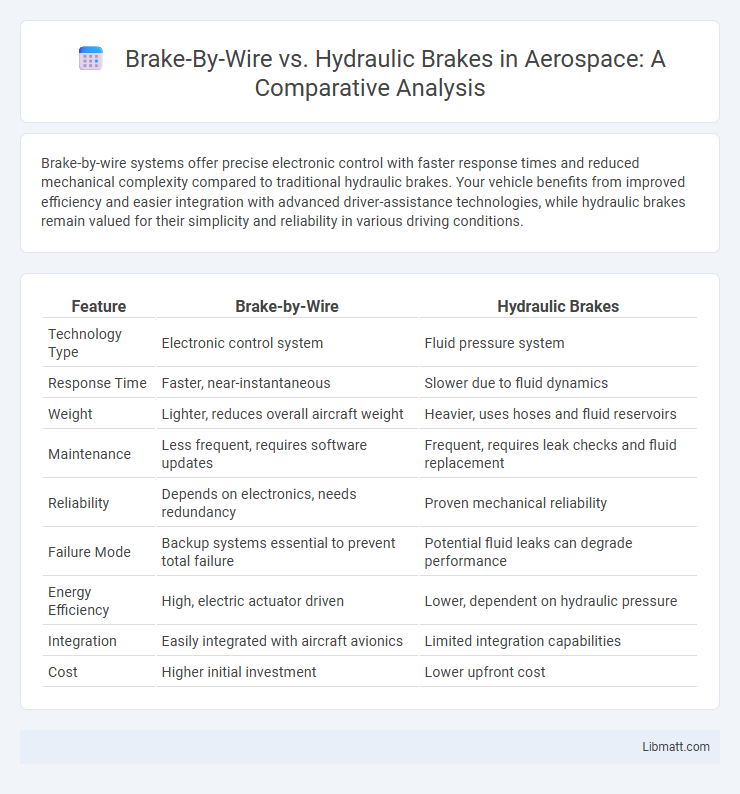Brake-by-wire systems offer precise electronic control with faster response times and reduced mechanical complexity compared to traditional hydraulic brakes. Your vehicle benefits from improved efficiency and easier integration with advanced driver-assistance technologies, while hydraulic brakes remain valued for their simplicity and reliability in various driving conditions.
Table of Comparison
| Feature | Brake-by-Wire | Hydraulic Brakes |
|---|---|---|
| Technology Type | Electronic control system | Fluid pressure system |
| Response Time | Faster, near-instantaneous | Slower due to fluid dynamics |
| Weight | Lighter, reduces overall aircraft weight | Heavier, uses hoses and fluid reservoirs |
| Maintenance | Less frequent, requires software updates | Frequent, requires leak checks and fluid replacement |
| Reliability | Depends on electronics, needs redundancy | Proven mechanical reliability |
| Failure Mode | Backup systems essential to prevent total failure | Potential fluid leaks can degrade performance |
| Energy Efficiency | High, electric actuator driven | Lower, dependent on hydraulic pressure |
| Integration | Easily integrated with aircraft avionics | Limited integration capabilities |
| Cost | Higher initial investment | Lower upfront cost |
Introduction to Brake-by-Wire and Hydraulic Brakes
Brake-by-wire systems replace traditional hydraulic components with electronic controls, offering precise braking response and reduced mechanical complexity. Hydraulic brakes rely on fluid pressure to transfer force from the brake pedal to the brake pads, ensuring reliable and time-tested stopping power. Understanding the differences between these technologies helps you choose the most effective braking system for modern vehicles.
How Brake-by-Wire Systems Work
Brake-by-wire systems replace traditional hydraulic connections with electronic controls that transmit braking commands from the driver to actuators at each wheel. Sensors detect pedal pressure and vehicle dynamics, converting these inputs into electrical signals that control motor-driven calipers or pumps, enabling precise brake force distribution. This technology enhances responsiveness, reduces mechanical complexity, and allows integration with advanced driver-assistance systems for improved safety and efficiency.
Understanding Traditional Hydraulic Brakes
Traditional hydraulic brakes use fluid pressure to transfer force from the brake pedal to the brake calipers, providing reliable and consistent stopping power. These systems rely on brake fluid circulating through a sealed system of lines and cylinders, converting driver input into mechanical force at the wheels. Hydraulic brakes remain the industry standard due to their simplicity, durability, and effective performance under a wide range of driving conditions.
Key Differences Between Brake-by-Wire and Hydraulic Brakes
Brake-by-wire systems use electronic controls to activate the braking mechanism, eliminating the need for traditional hydraulic fluid and mechanical linkages found in hydraulic brakes. Hydraulic brakes rely on fluid pressure transmitted through brake lines to apply force to the brake pads, making them mechanically simpler but more prone to leaks and maintenance issues. Brake-by-wire offers faster response times and integration with advanced vehicle safety systems, while hydraulic brakes provide a proven, reliable method with established performance in diverse driving conditions.
Performance Comparison: Responsiveness and Precision
Brake-by-wire systems offer superior responsiveness and precision compared to traditional hydraulic brakes due to their electronic control mechanisms, which eliminate mechanical lag and fluid dynamics delays. The instant signal transmission in brake-by-wire enables more accurate modulation of braking force, enhancing vehicle stability and control under diverse driving conditions. In contrast, hydraulic brakes rely on fluid pressure that can introduce minor delays and variability in pedal feel, making them less consistent in performance during rapid or repeated braking scenarios.
Safety and Reliability Factors
Brake-by-wire systems enhance safety through electronic control, enabling faster response times and real-time monitoring compared to traditional hydraulic brakes. Hydraulic brakes rely on fluid pressure, which can be prone to leaks or air bubbles, potentially reducing reliability during prolonged use or extreme conditions. Advanced brake-by-wire technology incorporates redundancy and fail-safe mechanisms, improving overall system dependability and minimizing brake failure risks.
Maintenance and Longevity Considerations
Brake-by-wire systems typically require less maintenance due to fewer moving parts and the absence of hydraulic fluid, reducing the risk of leaks and corrosion. Hydraulic brakes demand regular fluid checks and periodic replacement to prevent degradation and maintain optimal performance. The longevity of brake-by-wire systems is enhanced by electronic components designed for durability, whereas hydraulic systems' lifespan depends heavily on fluid quality and mechanical wear.
Cost Implications and Market Availability
Brake-by-wire systems generally entail higher upfront costs due to advanced electronic components and integration complexity, limiting their market availability primarily to premium and electric vehicles. Hydraulic brakes offer lower manufacturing and maintenance costs, making them widely available across various vehicle segments and regions. The cost disparity influences adoption rates, with manufacturers balancing technological benefits against consumer price sensitivity and regulatory compliance.
Applications in Modern Vehicles
Brake-by-wire systems are increasingly integrated into electric and autonomous vehicles, offering precise electronic control and improved response times compared to traditional hydraulic brakes. Hydraulic brakes remain prevalent in conventional gasoline and diesel vehicles due to their reliability and established technology. Your choice between brake-by-wire and hydraulic brakes impacts vehicle performance, maintenance needs, and compatibility with advanced driver-assistance systems (ADAS).
Future Trends in Automotive Braking Systems
Brake-by-wire systems offer enhanced precision, faster response times, and easier integration with advanced driver-assistance systems compared to traditional hydraulic brakes, making them central to the future of automotive braking technology. Innovations such as regenerative braking and electronic control modules are driving the shift toward fully electronic braking solutions that improve efficiency and safety. Your vehicle's braking system will increasingly rely on these cutting-edge technologies to meet evolving regulatory standards and support autonomous driving capabilities.
Brake-by-wire vs Hydraulic brakes Infographic

 libmatt.com
libmatt.com